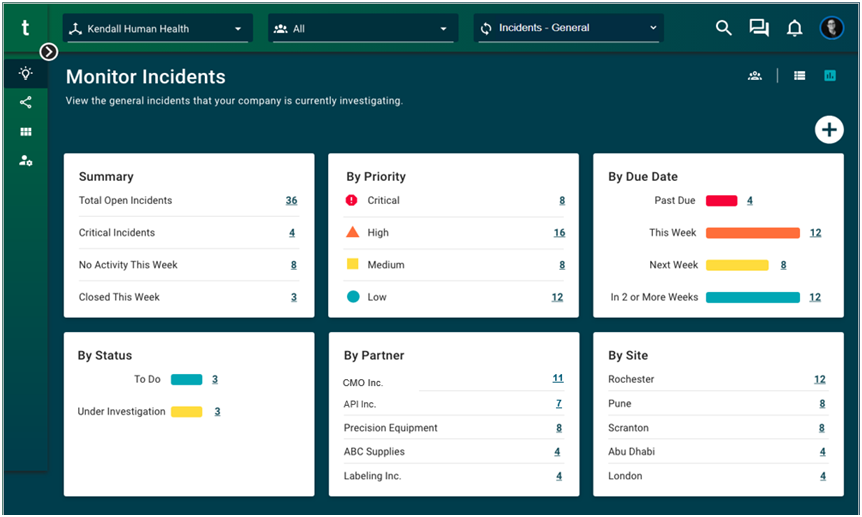Table of contents
There are many root causes for material shortages, but one common result is the manufacturing disruption and revenue shortfall created if they are not addressed quickly. The lingering impact of the pandemic, the increasing interdependence of industries, weather events, the complexity of global supply chains, and shipping capacity limitations have all contributed to creating material shortages across many industries. While there are numerous reasons for these shortages, these are not valid excuses to let customer service levels suffer. It is the main mission of every supply chain executive to mitigate the impact of shortages on the metrics of customer on-time, in-full (OTIF) and revenue.
The headlines are full of high-profile supply chain disruptions such as the global IC chip shortage, port congestion and shutdowns, the plastic shortage, and many others. The procurement, planning, and supply chain managers at most manufacturers must navigate through several of these disruptions at the same time to keep production lines running and customer orders delivered on time. While it is not possible to prevent most external disruptions, it is a best practice of great supply chain organizations to put processes in place to ensure they get early notifications of disruptions they cannot prevent. It is also a best practice to avoid being a victim of the same recurring issues and to work with partners to continuously improve supply chain processes and eliminate preventable problems such as material shortages.
There are many reasons for material shortages—ranging from a simple miscount by a warehouse shipping associate to the complex global IC chip shortage—that the chief procurement officer and engineering leadership must address. While some material shortages are caused by factors directly related to your supply chain, others are caused by external factors beyond your control, such as port congestion. The table below provides some examples of the many issues that lead to material shortages. These causes fall broadly into three categories: business process and quality defects on the buyer side; business process and quality defects on the supplier side; and external supply chain issues and disruptions.
Issues Leading to Material Shortages | |
Component/ingredient/raw material shortage at supplier | Inaccurate lead time on buyer side |
Quality deviations found at receiving inspection | Supplier capacity problems |
Goods damaged in transit | Complex production processes with variable yield |
Lost shipments | Commodity shortages |
Unexpected increase in demand | Environmental/geopolitical instability |
Longer than expected lead times at supplier | Transportation capacity issues |
Poor planning/forecasting on buyer side | Poor planning on the supplier side |
Short deliveries | Shipping delays/delays in transit |
Quality defects in production | Inventory accuracy |
Is your organization contributing to material shortages?
Let’s start with the material shortage issues that your supply chain organization has the most control over. These are the business process and quality defects on the buyer side—issues related to your planning, procurement, or manufacturing processes. These include unexpected increases in demand, poor planning and forecasting, inaccurate lead times, and transportation planning and capacity problems to name a few. Some of these issues may be identified as exceptions by the MRP process and can be considered a normal part of doing business and the responsibility of planners to follow up.
All supply chain organizations are impacted by issues like shortages regardless of whether these disruptions are unexpected or considered a normal part of the production process. But most cannot tell you how frequently they occur, what the root cause is, or what the financial or customer impact was from these shortages. While resourceful supply chain organizations will throw considerable resources at these problems once discovered to mitigate the impact on customer deliveries, this is usually through ad hoc processes coordinated through emails and spreadsheets. Generally, these issues will recur for a number of reasons:
- There is no follow up to determine the root cause.
- Ad hoc processes and long issue resolution times keeps everyone in firefighting mode and do not allow time for continuous improvement analysis to eliminate business process defects permanently.
- No history is retained to support future resolutions and help you determine how frequently the same issues recur.
- Resolution is generally local so there is no visibility into the same issue impacting other plants.
- A lack of coordinated collaboration with supply chain partners can lead to different conclusions on the root cause, which almost ensures that the issues will continue to recur.
To illustrate a real-word use case, let’s use an inaccurate lead time issue as an example. Purchase orders are generated by the ERP system during the MRP process based on lead times and lead time offsets stored in the item master data. The lead time and lead time offsets determine how far in advance of a finished good due date that a component needs to be ordered from the supplier. Lead times can vary depending on the quantity ordered and seasonality, especially when the quantity is increased significantly beyond the original shared forecast. This recently happened at many companies, causing the global IC chip shortage.
A lead time that is too short will lead to orders that are shipped short or shipped complete but miss the due date. This creates a material shortage at a production line or in a finished goods warehouse and an issue that needs to be chased down by buyer planners as they follow up on exceptions from the MRP process. Using an ad hoc process to resolve this issue, buyer planners will usually focus on getting the short materials in the door as quickly as possible, which could include second shifts at the supplier’s factory, expedited shipping, and second shifts at your plants—all leading to increased costs. Given the hundreds of exceptions that buyer planners must follow up on, there is very little or no time to spend determining the root cause—a lead time that is too short. It is possible that the supplier noted the lead time issue somewhere in one of the many emails that were exchanged. But this note was likely ignored and got lost after the immediate issue was closed and the email thread was deleted.
Supply chain digitalization is the answer to fewer material shortages
Fortunately, the improved visibility and collaboration needed to reduce material shortages is provided through supply chain digitalization. Sound complicated? With TraceLink Supply Work Issue Management, you can start your journey to supply chain digitalization in a few days. Supply Chain Work Management is a multienterprise work management solution that enables you to capture, analyze, and resolve supply chain issues up to 65% faster. Supply Chain Work Management provides a structured, workflow-driven collaboration platform that enables subject matter experts from your company and your suppliers’ companies to work together using the same solution and data to resolve issues. Powerful, real-time dashboards keep you and your suppliers aware of the most critical incidents, incident resolution status, and resolution processes that are falling behind. Suppliers with high open incident counts are always visible on the dashboard.
In the material shortage example, Supply Chain Work Management enables the shortage to be captured as soon as it is identified. Ideally, this issue is identified by the supplier as soon as they receive the order and recognize that the order cannot be produced in time to meet the customer’s requested delivery date. Supply Chain Work Management enables your suppliers to report the incident the moment they identify the lead time problem. The incident will display instantly on the Monitor Incidents Dashboard for planners and managers to see, and the resolution process can begin weeks or months before the material shortage would have been identified by your planner in the exception report or found in the late receipts report. The resolution process for material shortage issues discovered in the late receipt report will focus on getting more material, not fixing the lead time.

Inaccurate lead times are a systematic problem and will recur until fixed. The issue is also likely to impact multiple products if it is a common component. It may even impact multiple suppliers if there is a business process defect in the methodology used for setting lead times. Supply Chain Work Management retains the history of issues resolved with input from your subject matter experts and those at your suppliers. While the immediate resolution will be focused on getting the additional material, the root cause can also be collected if known at the time. A review across closed material shortage issues enables you to determine how many of these shortages are essentially self-inflicted because of inaccurate lead times. The good news is that once discovered, fixing an inaccurate lead time only requires a small update in the ERP system.
Supply Chain Work Management resolution history data can also be used to support continuous improvement methodologies such as Six Sigma. Identifying inaccurate lead times is just the first step. Improving the process for determining lead times with input from suppliers is needed to address the systemic problem of inaccurate lead times. Companies using Supply Chain Work Management resolution history data to support the define, measure, and analyze steps of Six Sigma have reduced manufacturing disruptions by as much as 97%.
Preventing material shortages is complicated, but possible
Inaccurate lead time is just one of many possible causes for a material shortage. Supply Chain Work Management provides an easy way to begin the process of determining the root causes of problems in your supply chain processes that may be contributing to material shortages. The good news is that the impact of material shortages on OTIF delivery to customers can be mitigated and future shortages prevented by improving visibility, collaboration, and resolution processes with suppliers.
How to mitigate the impact of material shortages on customers:
- Deploy Supply Chain Work Management to identify the potential material shortage as soon as possible.
- Create incidents for MRP planning exceptions in order to immediately notify the supplier and begin the resolution process.
- Collaborate with suppliers to determine when the rest of the order will be delivered.
- Explore the potential of second shifts and expedited shipping to fill the shortage earlier.
- Determine internal impact of shortages and adjust production schedule or customer order allocations accordingly.
- Reduce production plans and distribution allocation to accommodate the shortage.
- Source from an alternate supplier.
- Borrow material from a sister plant.
- Fulfill the order from another warehouse.
How to permanently resolve material shortages:
- Review Supply Chain Work Management resolution history to determine most problematic processes.
- Build stronger relationships with suppliers and encourage them to report potential issues as soon as possible with the understanding that no issue is too small to report.
- Improve processes for planning and forecast sharing between you and your suppliers.
- Collaborate with suppliers to establish accurate lead times and adjust lead times for quantity and seasonality as required.
- Establish direct contracts with upstream suppliers to secure supply and reduce the bullwhip effect.
- Work with suppliers to address manufacturing process complexity and yield issues.
These are just some of the steps to mitigate and prevent material shortage issues. Supply Chain Work Management will help your planners identify which steps apply to your specific material shortage issue and help you spot other issues that contribute to reduced OTIF and customer service levels.
Improve customer service levels and grow revenue
Every company’s supply chain has its own processes and its own unique combination of challenges and issues. What every company’s supply chain operations have in common is that internal and external supply chain issues will continue to impact OTIF and revenue until resolved. With the constant barrage of new supply chain disruptions occurring daily, there has never been a more critical time to put a better issue management and resolution process in place. While your customers may sympathize with you over the many external supply chain issues that keep you from delivering on-time/in-full, they have their own revenue targets to hit and will find alternate suppliers.
TraceLink Supply Chain Work Management is a quick and easy way to harness the power of your team’s expertise and that of your suppliers’ so you can all navigate these difficult times and get ahead of your competition. This will enable your supply chain organization to overcome the current supply chain challenges, acquire new customers, and grow revenue.
Learn more in our Supply Chain Work Management Resource Center.





